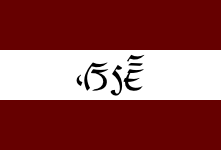
Lepcha Script
Endangered Language
The United Nations Educational, Scientific and Cultural Organization (UNESCO) lists Lepcha as an endangered language with the following characterization:
The Lepcha language is spoken in Sikkim and Darjeeling district in West Bengal of India. The 1991 Indian census counted 39,342 speakers of Lepcha. Lepcha is considered to be one of the indigenous languages of the area in which it is spoken. Unlike most other languages of the Himalayas, the Lepcha people have their own indigenous script (the world's largest collection of old Lepcha manuscripts is kept in Leiden, with over 180 Lepcha books).
Lepcha is the language of instruction in some schools in Sikkim. In comparison to other Tibeto-Burman languages, it has been given considerable attention in the literature. Nevertheless, many important aspects of the Lepcha language and culture still remain undescribed.
Resource: Lepcha - Endangered Language (mp4, 8.8 MB)
Origin
Róng Aríng - more commonly known as Lepcha - is a complex Asian script of Abugida type, with certain similarities to Tibetan and Brahmi scripts. Indigenous tradition attributes the development of the script to Thikung Mensalong (thi kúng men sa lóng), an ancient Lepcha scholar and Bóngthíng. Other sources date the creation of the Rong script to the era of Chogyal Chagdor Namgyal (chos rgyal phyag rdor rnam rgyal) and Lhatsun Namkha Jigme (lha btsun nam mkha' 'jigs med), which does not necessarily contradict the former statement. Certain features - such as the inconsistent representation of medials - suggest development in several steps by different originators. The oldest extant Lepcha manuscripts date back to the 18th century while the first printed text, a translation of the Gospel of St. Matthew, was published in 1845.
Structure
The basic structure of syllables usually starts with an initial consonant to which a medial consonant, a final consonant, a vowel sign and/or diacritics may be added. This can happen in any direction which probably represents the most unusual feature of the script. Up to two glyphs may be attached to the left, to the bottom and on top, while up to three glyphs may follow to the right of the initial as illustrated in the following diagram. The exemplary 'syllable' presented is, however, an artificial construct which does not make sense and which will never occur that way.

Róngríng for the Digital Age
The onset of the new millennium brought along the introduction of electronic text processing for Róngríng with two custom encoded TrueType fonts, both released in 2001:
- Shipmoo, designed and developed by Ren Ugen Shipmoo
- JG Lepcha, designed and developed by Jason Glavy
The Lepcha script was incorporated into the Unicode standard in 2008. Several attempts for the implementation of Unicode compliant Lepcha fonts were undertaken, so far:
- Lepcha Language Kit for OS X released by Xenotype Technologies in 2003
- Mingzat, under development by SIL International since 2013
- Noto Sans Lepcha under development by Google since 2013
Besides, mention is due for a bitmap font covering the whole range of scripts in Unicode's Basic Multilingual Plane:
- GNU Unifont including the Lepcha block since 2008
Presently, most Lepcha writers stick to handwriting or text processing using the legacy fonts, despite their obvious disadvantages. Poor general acceptance of Unicode fonts may be based on several reasons: While the first mentioned is no longer available, the presently accessible fonts are either partly dysfunctional, restricted to a narrow software environment, lacking an appropriate input system, and/or not felt to look appealingly.
Thus, SIBLAC attempts to provide a stimulus to the indigenous literary tradition with the release of a state-of-the-art cross-platform Unicode kit, including complete and fail-safe OpenType fonts as well as an intuitive keyboard layout for the prevalent operating systems. The package does not want to replace handwriting, it's thought as an optional accessory for instant exchange and long-term digital storage of documents in Róngríng.
Róng Kít is available for Windows, Mac OS X and Linux free of charge for personal and NGO use. A licence is required for governmental and commercial use. Terms and conditions for concerned agencies are available on request.
Enquiries, bug reports or requests for assistance may be made using our Feedback page. Response can usually be expected within a few hours.
Róng Kít Downloads

Syllabaries: